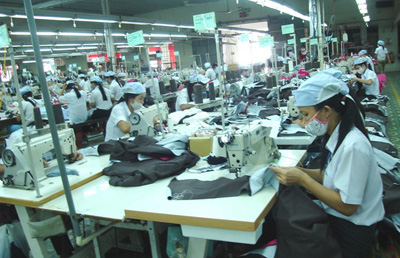Employers discuss 2015 minimum wage increase, better co-ordination and evidence-based data needed

illustration photo
The Vietnam Chamber of Commerce and Industry (VCCI), Vietnam Co-operative Alliance (VCA), Vietnam Association of Small and Medium-sized Enterprises, Vietnam Garment and Textile Association (VITAS) and other sectorial associations sat down together in Hanoi today to discuss “Employers’ proposal on adjustment of minimum wages for 2015” at a workshop co-organised by VCCI and the International Labor Organization (ILO).
According to the statistics of VCCI, regional minimum wages in Vietnam grew on average by 9.9 per cent in 2010, 30.1 per cent in 2012 and 15.2 per cent this year. The growth rate of regional minimum wages was equivalent to that of CPI in 2010-2011 but three times higher than CPI growth since 2012.
“The increase of minimum wages for 2015 should ensure both the actual salaries of workers and the production of enterprises,” said VCCI Employers’ Bureau director Phung Quang Huy.
According to VCCI, minimum wage adjustment mostly affects garment, footwear and fishery industries.
“Increasing minimum wages by 10 per cent could increase enterprises’ costs for salaries by over 17 per cent due to increased allowances and other social benefits,” said VCCI Employers’ Bureau deputy director Vi Thi Hong Minh.
Representing employers’ organisations at the National Wage Council are VCCI, VCA, Vietnam Association of Small and Medium-sized Enterprises, Vietnam Leather and Footwear Association, and VITAS.
ILO Vietnam’s chief technical advisor on Industrial Relations, Phillip Hazelton, said that it was important to enable and encourage joint and evidence-based discussion and interventions of key employers’ groups on minimum wage adjustment.
The ILO encourages a stronger co-ordination role of VCCI in working with other employer’s organisations on the National Wage Council and hopes that “different associations will be able to work more closely on joint studies and joint activities around this important area”.
“We urge minimum wage adjustment proposals of employers’ organisations and the trade union side to be based on the use of reliable statistics and sound data analysis, taking into consideration both social and economic criteria,” Hazelton added.
Minimum wage is a single wage floor level below which employers cannot go legally.
The ILO suggests that the negotiations should look into the needs of workers and economic factors such as payment ability and competitiveness.
“Minimum wage has limitations and it should not be used to address all poverty issues,” said ILO senior specialist on Employers’ Activities, Gary Rynhart.
He advised Vietnam to avoid indexing minimum wages to CPI because CPI measures changes in prices without providing information on incomes and does not cover all household expenditure.
Regional minimum wages in Vietmam are now deliberated on by the National Wage Council, which was established in 2013 and gave an equal voice to the government, employers’ organisations and trade unions.
Minimum wages for 2014 range from VND1.9 million ($90) to VND2.7 million ($129) per month depending on regions.
What the stars mean:
★ Poor ★ ★ Promising ★★★ Good ★★★★ Very good ★★★★★ Exceptional
Latest News
More News
- Growth beckons for GenAI startups in Vietnam (November 21, 2024 | 17:47)
- SABECO to elevate Vietnam's beverage industry to global standards (November 21, 2024 | 17:36)
- ABeam Consulting Vietnam introduces BSQCD Purchasing Strategy Framework (November 21, 2024 | 16:40)
- Major railway requires debt considerations (November 21, 2024 | 12:07)
- Reviving a new life cycle for plastic waste (November 21, 2024 | 09:16)
- Key balances maintained for industrial production (November 21, 2024 | 08:00)
- Ecolean Vietnam honoured with prestigious sustainability award (November 19, 2024 | 10:01)
- HEINEKEN Vietnam’s clear path towards net-zero (November 18, 2024 | 15:13)
- VLCA 2024 honours corporate governance excellence as listed companies raise the bar (November 18, 2024 | 09:00)
- High-tech personnel to drive competition (November 17, 2024 | 09:21)


















 Mobile Version
Mobile Version